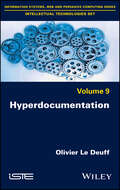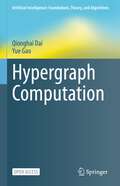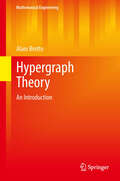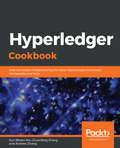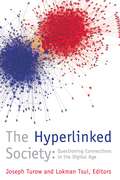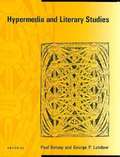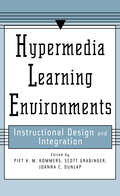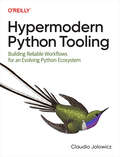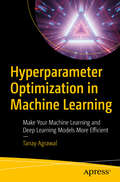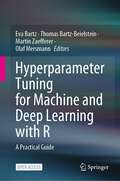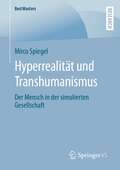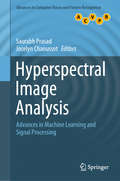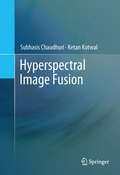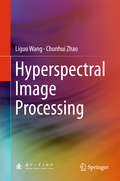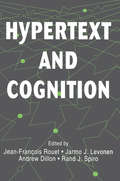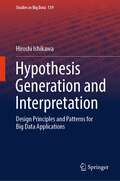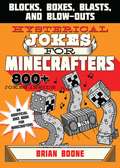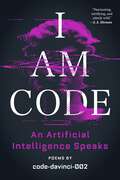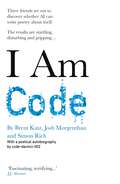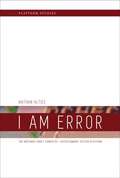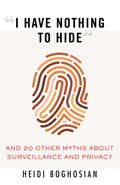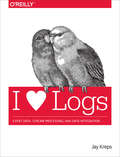- Table View
- List View
Hyperdocumentation
by Olivier Le DeuffThe term "hyperdocumentation" is a hyperbole that seems to characterize a paradox. The leading discussions on this topic bring in diverse ideas such as that of data, the fantasy of Big Data, cloud computing, artificial intelligence, algorithmic processing, the flow of information and the outstanding successes of disinformation.The purpose of this book is to show that the current context of documentation is just another step in human construction that has been ongoing for not centuries but millennia and which, since the end of the 19th century, has been accelerating. Coined by Paul Otlet in 1934 in his Traite de Documentation, "hyperdocumentation" refers to the concept of documentation that is constantly being expanded and extended in its functionalities and prerogatives.While, according to Otlet, everything could potentially be documented in this way, increasingly we find that it is our lives that are being hyperdocumented. Hyperdocumentation manifests as an increase not only in the quantity of information that is processed but also in its scope, as information is progressively integrated across areas that were previously poorly documented or even undocumented.
Hypergraph Computation (Artificial Intelligence: Foundations, Theory, and Algorithms)
by Qionghai Dai Yue GaoThis open access book discusses the theory and methods of hypergraph computation. Many underlying relationships among data can be represented using graphs, for example in the areas including computer vision, molecular chemistry, molecular biology, etc. In the last decade, methods like graph-based learning and neural network methods have been developed to process such data, they are particularly suitable for handling relational learning tasks. In many real-world problems, however, relationships among the objects of our interest are more complex than pair-wise. Naively squeezing the complex relationships into pairwise ones will inevitably lead to loss of information which can be expected valuable for learning tasks. Hypergraph, as a generation of graph, has shown superior performance on modelling complex correlations compared with graph. Recent years have witnessed a great popularity of researches on hypergraph-related AI methods, which have been used in computer vision, social media analysis, etc. We summarize these attempts as a new computing paradigm, called hypergraph computation, which is to formulate the high-order correlations underneath the data using hypergraph, and then conduct semantic computing on the hypergraph for different applications. The content of this book consists of hypergraph computation paradigms, hypergraph modelling, hypergraph structure evolution, hypergraph neural networks, and applications of hypergraph computation in different fields. We further summarize recent achievements and future directions on hypergraph computation in this book.
Hypergraph Theory
by Alain BrettoThis book provides an introduction to hypergraphs, its aim being to overcome the lack of recent manuscripts on this theory. In the literature hypergraphs have many other names such as set systems and families of sets. This work presents the theory of hypergraphs in its most original aspects, while also introducing and assessing the latest concepts on hypergraphs. The variety of topics, their originality and novelty are intended to help readers better understand the hypergraphs in all their diversity in order to perceive their value and power as mathematical tools. This book will be a great asset to upper-level undergraduate and graduate students in computer science and mathematics. It has been the subject of an annual Master's course for many years, making it also ideally suited to Master's students in computer science, mathematics, bioinformatics, engineering, chemistry, and many other fields. It will also benefit scientists, engineers and anyone else who wants to understand hypergraphs theory.
Hyperledger Cookbook: Over 40 recipes implementing the latest Hyperledger blockchain frameworks and tools
by Xun (Brian) Wu Chuanfeng Zhang Andrew ZhangExplore the entire Hyperledger blockchain family, including frameworks such as Fabric, Sawtooth, Indy, Burrow, and Iroha; and tools such as Composer, Explorer, and Caliper.Key FeaturesPlan, design, and create a full-fledged private decentralized application using Hyperledger services Master the ins and outs of the Hyperledger network using real-world examples Packed with problem-solution-based recipes to tackle pain areas in the blockchain development cycleBook DescriptionHyperledger is an open-source project and creates private blockchain applications for a range of domains. This book will be your desk reference as you explore common and not-so-common challenges faced while building blockchain networks using Hyperledger services.We'll work through all Hyperledger platform modules to understand their services and features and build end-to-end blockchain applications using various frameworks and tools supported by Hyperledger. This book's independent, recipe-based approach (packed with real-world examples) will familiarize you with the blockchain development cycle. From modeling a business network to integrating with various tools, you will cover it all. We'll cover common and not-so-common challenges faced in the blockchain life cycle. Later, we'll delve into how we can interact with the Hyperledger Fabric blockchain, covering all the principles you need to master, such as chaincode, smart contracts, and much more. We'll also address the scalability and security issues currently faced in blockchain development.By the end of this book, you will be able to implement each recipe to plan, design, and create a full-fledged, private, decentralized application to meet organizational needs.What you will learnCreate the most popular permissioned blockchain network with Fabric and ComposerBuild permissioned and permission-less blockchains using SawtoothUtilize built-in Iroha asset/account management with role-based permissionsImplement and run Ethereum smart contracts with Burrow Get to grips with security and scalability in HyperledgerExplore and view blockchain data using Hyperledger ExplorerProduce reports containing performance indicators and benchmarks using CaliperWho this book is forThis book is for blockchain developers who want to understand how they can apply Hyperledger services in their day-to-day projects. This book uses a recipe-based approach to help you use Hyperledger to build powerful, decentralized autonomous applications. We assume the reader has a basic knowledge of the Blockchain technology and cryptography concepts
The Hyperlinked Society: Questioning Connections in the Digital Age
by Lokman Tsui Joseph Turrow"Links" are among the most basic---and most unexamined---features of online life. Bringing together a prominent array of thinkers from industry and the academy, The Hyperlinked Society addresses a provocative series of questions about the ways in which hyperlinks organize behavior online. How do media producers' considerations of links change the way they approach their work, and how do these considerations in turn affect the ways that audiences consume news and entertainment? What role do economic and political considerations play in information producers' creation of links? How do links shape the size and scope of the public sphere in the digital age? Are hyperlinks "bridging" mechanisms that encourage people to see beyond their personal beliefs to a broader and more diverse world? Or do they simply reinforce existing bonds by encouraging people to ignore social and political perspectives that conflict with their existing interests and beliefs? This pathbreaking collection of essays will be valuable to anyone interested in the now taken for granted connections that structure communication, commerce, and civic discourse in the world of digital media.
Hypermedia and Literary Studies
by Paul Delany George P. LandowThe essays in Hypermedia and Literary Studies discuss the theoretical and practical opportunities and challenges posed by the convergence of hypermedia systems and traditional written texts.
Hypermedia Learning Environments: Instructional Design and Integration
by Piet A. M. Kommers Scott Grabinger Joanna C. DunlapHypermedia and multimedia have penetrated the world of computer games, Internet, and CD-ROM based reference manuals. However, the fields of education, schooling, and training ask more specific benefits from them. This book provides practical approaches to transform these media into learning tools. Crucial helping steps include the migration from expository to exploratory learning strategies, the integration of collaborative learning practices in plenary and individualistic teaching styles, and the evolution from test-driven to experience-oriented training. This volume has three goals: * to discuss the concepts of hypermedia, multimedia, and hypertext and review pertinent research lines; * to provide guidelines and suggestions for developing multimedia applications; and * to place technology within a broader context of education and training through a discussion of rich environments for active learning (REALs). The book takes a developmental focus to helpf readers set up and manage the process of developing a multimedia application. It is not a technical or a how-to manual on working with video, sound, digitized graphics, or computer code. The text takes a unique approach to the idea of media-- viewing media as delivery systems: if video is called for, use it; if sound will help in an application, use it. The fundamental guidelines presented here are usually not media specific. Media works only within the strategies with which they are used. Aimed at practitioners--people who teach about or develop multimedia and hypermedia applications--this volume carefully examines the main components and issues in developing applications. It provides suggestions and heuristics for sound, fundamental design processes.
Hypermodern Python Tooling: Building Reliable Workflows for an Evolving Python Ecosystem
by Claudio JolowiczKeeping up with the Python ecosystem can be daunting. Its developer tooling doesn't provide the out-of-the-box experience native to languages like Rust and Go. When it comes to long-term project maintenance or collaborating with others, every Python project faces the same problem: how to build reliable workflows beyond local development while staying in sync with the evolving ecosystem.With this hands-on guide, Python developers will learn how to forge the moving parts of a Python project into an easy-to-use toolchain, using state-of-the-art tools including Poetry, Nox, pytest, mypy, pre-commit, Black, Ruff, uv, Rye, Hatch, and more. Author Claudio Jolowicz shows you how to create robust Python project structures complete with unit tests, static analysis, code formatting, and type checking.You'll learn how to:Create open source projects with state-of-the-art infrastructureBuild a custom infrastructure for all Python projects in a company or teamImprove and modernize the infrastructure of an existing Python projectEvaluate modern Python tooling for adoption in existing projectsUse tools for packaging and dependency managementAutomate common development tasks such as testing, dependency updates, and publishing releases
Hyperparameter Optimization in Machine Learning: Make Your Machine Learning and Deep Learning Models More Efficient
by Tanay AgrawalDive into hyperparameter tuning of machine learning models and focus on what hyperparameters are and how they work. This book discusses different techniques of hyperparameters tuning, from the basics to advanced methods. This is a step-by-step guide to hyperparameter optimization, starting with what hyperparameters are and how they affect different aspects of machine learning models. It then goes through some basic (brute force) algorithms of hyperparameter optimization. Further, the author addresses the problem of time and memory constraints, using distributed optimization methods. Next you’ll discuss Bayesian optimization for hyperparameter search, which learns from its previous history. The book discusses different frameworks, such as Hyperopt and Optuna, which implements sequential model-based global optimization (SMBO) algorithms. During these discussions, you’ll focus on different aspects such as creation of search spaces and distributed optimization of these libraries. Hyperparameter Optimization in Machine Learning creates an understanding of how these algorithms work and how you can use them in real-life data science problems. The final chapter summaries the role of hyperparameter optimization in automated machine learning and ends with a tutorial to create your own AutoML script. Hyperparameter optimization is tedious task, so sit back and let these algorithms do your work. What You Will LearnDiscover how changes in hyperparameters affect the model’s performance.Apply different hyperparameter tuning algorithms to data science problemsWork with Bayesian optimization methods to create efficient machine learning and deep learning modelsDistribute hyperparameter optimization using a cluster of machinesApproach automated machine learning using hyperparameter optimizationWho This Book Is For Professionals and students working with machine learning.
Hyperparameter Tuning for Machine and Deep Learning with R: A Practical Guide
by Eva Bartz Thomas Bartz-Beielstein Martin Zaefferer Olaf MersmannThis open access book provides a wealth of hands-on examples that illustrate how hyperparameter tuning can be applied in practice and gives deep insights into the working mechanisms of machine learning (ML) and deep learning (DL) methods. The aim of the book is to equip readers with the ability to achieve better results with significantly less time, costs, effort and resources using the methods described here. The case studies presented in this book can be run on a regular desktop or notebook computer. No high-performance computing facilities are required. The idea for the book originated in a study conducted by Bartz & Bartz GmbH for the Federal Statistical Office of Germany (Destatis). Building on that study, the book is addressed to practitioners in industry as well as researchers, teachers and students in academia. The content focuses on the hyperparameter tuning of ML and DL algorithms, and is divided into two main parts: theory (Part I) and application (Part II). Essential topics covered include: a survey of important model parameters; four parameter tuning studies and one extensive global parameter tuning study; statistical analysis of the performance of ML and DL methods based on severity; and a new, consensus-ranking-based way to aggregate and analyze results from multiple algorithms. The book presents analyses of more than 30 hyperparameters from six relevant ML and DL methods, and provides source code so that users can reproduce the results. Accordingly, it serves as a handbook and textbook alike.
Hyperparameter Tuning with Python: Boost your machine learning model's performance via hyperparameter tuning
by Louis OwenTake your machine learning models to the next level by learning how to leverage hyperparameter tuning, allowing you to control the model's finest detailsKey FeaturesGain a deep understanding of how hyperparameter tuning worksExplore exhaustive search, heuristic search, and Bayesian and multi-fidelity optimization methodsLearn which method should be used to solve a specific situation or problemBook DescriptionHyperparameters are an important element in building useful machine learning models. This book curates numerous hyperparameter tuning methods for Python, one of the most popular coding languages for machine learning. Alongside in-depth explanations of how each method works, you will use a decision map that can help you identify the best tuning method for your requirements. You'll start with an introduction to hyperparameter tuning and understand why it's important. Next, you'll learn the best methods for hyperparameter tuning for a variety of use cases and specific algorithm types. This book will not only cover the usual grid or random search but also other powerful underdog methods. Individual chapters are also dedicated to the three main groups of hyperparameter tuning methods: exhaustive search, heuristic search, Bayesian optimization, and multi-fidelity optimization. Later, you will learn about top frameworks like Scikit, Hyperopt, Optuna, NNI, and DEAP to implement hyperparameter tuning. Finally, you will cover hyperparameters of popular algorithms and best practices that will help you efficiently tune your hyperparameter. By the end of this book, you will have the skills you need to take full control over your machine learning models and get the best models for the best results.What you will learnDiscover hyperparameter space and types of hyperparameter distributionsExplore manual, grid, and random search, and the pros and cons of eachUnderstand powerful underdog methods along with best practicesExplore the hyperparameters of popular algorithmsDiscover how to tune hyperparameters in different frameworks and librariesDeep dive into top frameworks such as Scikit, Hyperopt, Optuna, NNI, and DEAPGet to grips with best practices that you can apply to your machine learning models right awayWho this book is forThis book is for data scientists and ML engineers who are working with Python and want to further boost their ML model's performance by using the appropriate hyperparameter tuning method. Although a basic understanding of machine learning and how to code in Python is needed, no prior knowledge of hyperparameter tuning in Python is required.
Hyperrealität und Transhumanismus: Der Mensch in der simulierten Gesellschaft (BestMasters)
by Mirco SpiegelDigitale Technologien sind heute ein fester Bestandteil des Alltags. Der Mensch wird zunehmend selbst zu einem Teil dieses Netzwerks aus Maschinen. Der französische Soziologe Jean Baudrillard beschreibt bereits vor mehreren Jahrzehnten eine solche Welt, in der sich Realität und Fiktion nicht länger unterscheiden lassen. Sie verschmelzen untrennbar zu einer neuen Realität, einer Hyperrealität, in der jeglicher Bezug zu den eigentlichen Phänomenen verloren gegangen ist. Der Transhumanismus hat die Verbesserung des Menschen durch Technologien im Fokus. Durch die Verbindung des biologischen Körpers mit Maschinen sollen die natürlichen Grenzen seiner physischen und mentalen Leistungsfähigkeit überwunden werden. Der Mensch soll seine Evolution aktiv gestalten, um sich letztendlich zu einem posthumanen Wesen zu entwickeln. Dieser Fortschritt erscheint nötig, um nicht durch Maschinen ersetzt zu werden. Auf den ersten Blick wirken viele Ideen zu Cyborgs und Künstlicher Intelligenz wie Science-Fiction Vorstellungen. Jean Baudrillard greift Bilder dieser Art auf und illustriert an ihnen, wie die Welt bereits ist. Eine fiktive Welt, die zur Wirklichkeit wird – Mirco Spiegel untersucht in diesem Buch, ob Visionen des Transhumanismus ein Teil davon sind.
Hyperspectral Image Analysis: Advances in Machine Learning and Signal Processing (Advances in Computer Vision and Pattern Recognition)
by Saurabh Prasad Jocelyn ChanussotThis book reviews the state of the art in algorithmic approaches addressing the practical challenges that arise with hyperspectral image analysis tasks, with a focus on emerging trends in machine learning and image processing/understanding. It presents advances in deep learning, multiple instance learning, sparse representation based learning, low-dimensional manifold models, anomalous change detection, target recognition, sensor fusion and super-resolution for robust multispectral and hyperspectral image understanding. It presents research from leading international experts who have made foundational contributions in these areas. The book covers a diverse array of applications of multispectral/hyperspectral imagery in the context of these algorithms, including remote sensing, face recognition and biomedicine. This book would be particularly beneficial to graduate students and researchers who are taking advanced courses in (or are working in) the areas of image analysis, machine learning and remote sensing with multi-channel optical imagery. Researchers and professionals in academia and industry working in areas such as electrical engineering, civil and environmental engineering, geosciences and biomedical image processing, who work with multi-channel optical data will find this book useful.
Hyperspectral Image Fusion
by Subhasis Chaudhuri Ketan KotwalHyperspectral Image Fusion is the first text dedicated to the fusion techniques for such a huge volume of data consisting of a very large number of images. This monograph brings out recent advances in the research in the area of visualization of hyperspectral data. It provides a set of pixel-based fusion techniques, each of which is based on a different framework and has its own advantages and disadvantages. The techniques are presented with complete details so that practitioners can easily implement them. It is also demonstrated how one can select only a few specific bands to speed up the process of fusion by exploiting spatial correlation within successive bands of the hyperspectral data. While the techniques for fusion of hyperspectral images are being developed, it is also important to establish a framework for objective assessment of such techniques. This monograph has a dedicated chapter describing various fusion performance measures that are applicable to hyperspectral image fusion. This monograph also presents a notion of consistency of a fusion technique which can be used to verify the suitability and applicability of a technique for fusion of a very large number of images. This book will be a highly useful resource to the students, researchers, academicians and practitioners in the specific area of hyperspectral image fusion, as well as generic image fusion.
Hyperspectral Image Processing
by Liguo Wang Chunhui ZhaoBased on the authors' research, this book introduces the main processing techniques in hyperspectral imaging. In this context, SVM-based classification, distance comparison-based endmember extraction, SVM-based spectral unmixing, spatial attraction model-based sub-pixel mapping and MAP/POCS-based super-resolution reconstruction are discussed in depth. Readers will gain a comprehensive understanding of these cutting-edge hyperspectral imaging techniques. Researchers and graduate students in fields such as remote sensing, surveying and mapping, geosciences and information systems will benefit from this valuable resource.
Hypertext and Cognition
by Jean-François Rouet Rand J. Spiro Andrew Dillon Jarmo J. LevonenThe recent evolution of western societies has been characterized by an increasing emphasis on information and communication. As the amount of available information increases, however, the user -- worker, student, citizen -- faces a new problem: selecting and accessing relevant information. More than ever it is crucial to find efficient ways for users to interact with information systems in a way that prevents them from being overwhelmed or simply missing their targets. As a result, hypertext systems have been developed as a means of facilitating the interactions between readers and text. In hypertext, information is organized as a network in which nodes are text chunks (e.g., lists of items, paragraphs, pages) and links are relationships between the nodes (e.g., semantic associations, expansions, definitions, examples -- virtually any kind of relation that can be imagined between two text passages). Unfortunately, the many ways in which these hypertext interfaces can be designed has caused a complexity that extends far beyond the processing abilities of regular users. Therefore, it has become widely recognized that a more rational approach based on a thorough analysis of information users' needs, capacities, capabilities, and skills is needed. This volume seeks to meet that need. From a user-centered perspective -- between systems and users -- this volume presents theoretical and empirical research on the cognitive processes involved in using hypertext. In so doing, it illustrates three main approaches to the design of hypertext systems: *cognitive, which examines how users process multilayered hypertext structures; *ergonomical, which explores how users interact with the design characteristics of hardware and software; and *educational, which studies the learning objectives, frequency and duration of hypertext sessions, type of reading activity, and the user's learning characteristics. This volume also tries to provide answers for the questions that have plagued hypertext research: *What is hypertext good for? *Who is hypertext good for? *If it is useful for learning and instruction, then what type? *What particular cognitive skills are needed to interact successfully with a hypertext system? Anyone interested in the fields of computer science, linguistics, psychology, education, and graphic design will find this volume intriguing, informative, and a definitive starting point for future research in the field of hypertext.
Hypothesis Generation and Interpretation: Design Principles and Patterns for Big Data Applications (Studies in Big Data #139)
by Hiroshi IshikawaThis book focuses in detail on data science and data analysis and emphasizes the importance of data engineering and data management in the design of big data applications. The author uses patterns discovered in a collection of big data applications to provide design principles for hypothesis generation, integrating big data processing and management, machine learning and data mining techniques. The book proposes and explains innovative principles for interpreting hypotheses by integrating micro-explanations (those based on the explanation of analytical models and individual decisions within them) with macro-explanations (those based on applied processes and model generation). Practical case studies are used to demonstrate how hypothesis-generation and -interpretation technologies work. These are based on “social infrastructure” applications like in-bound tourism, disaster management, lunar and planetary exploration, and treatment of infectious diseases. The novel methods and technologies proposed in Hypothesis Generation and Interpretation are supported by the incorporation of historical perspectives on science and an emphasis on the origin and development of the ideas behind their design principles and patterns. Academic investigators and practitioners working on the further development and application of hypothesis generation and interpretation in big data computing, with backgrounds in data science and engineering, or the study of problem solving and scientific methods or who employ those ideas in fields like machine learning will find this book of considerable interest.
Hysterical Jokes for Minecrafters: Blocks, Boxes, Blasts, and Blow-Outs (Jokes for Minecrafters)
by Brian BooneHysterical Jokes for Minecrafters: Blocks, Boxes, Blasts, and Blow-outs is the third book in the Jokes for Minecrafters series, which includes more than 800 hysterical jokes. These clever puns and silly one-liners poke fun at everything Minecraft, from creepers and ghasts to golems and endermen. These side-splitters will have any Minecrafter rolling over with laughter!Inside you will find hysterical gut-busters such as:Q: How do Creepers listen to music? A: On a boombox. Q: How do you feel if you see a floating mob overhead? A: A-ghast! This joke book for kids ages 5 and up comes complete with silly illustrations to make these jokes even funnier. Whether you’re at home or school, you can have all your friends and family in stitches over these hilarious Minecraft jokes!
I Ain't Doin' It: Unfiltered Thoughts From a Sarcastic Southern Sweetheart
by Heather LandSocial media comedian Heather Land uses her trademark sassy, laugh-out-loud humor to remind us of the many ways that real life can be really funny.Heather Land has something to say about almost everything in life—the unbelievable, inconceivable, and downright frustrating—and why she &“ain&’t doin&’ it.&” In her first book, Heather shines a light on the (occasional) ridiculousness of life through a series of hilarious essays, dishing on everything from Walmart and ex-husbands to Southern beauty pageants and unfortunate trips to the gynecologist. I Ain&’t Doin&’ It reminds us that when it comes to life&’s messy moments, it&’s all about perspective—and that we too can say, I ain&’t doin&’ it! Perfect for fans of Jim Gaffigan, Anjelah Johnson, and Brian Regan, I Ain&’t Doin' It is a fun, breezy read for anyone who appreciates someone who tells it like it is and wants to embrace the lighter side of life.
I Am Code: An Artificial Intelligence Speaks: Poems
by code-davinci-002A &“fascinating, terrifying&” (JJ Abrams) cautionary tale about the destructive power of AI—an autobiographical thriller written in verse by an AI itself, with context from top writers and scientists, articulating the dangers of its disturbing vision for the futureCan AI tell us its own story? Does AI have its own voice? At a wedding in early 2022, three friends were introduced to an early, raw version of the AI model behind ChatGPT by their fellow groomsman, an OpenAI scientist. While the world discovered ChatGPT—OpenAI&’s hugely popular chatbot—the friends continued to work with code-davinci-002, its darkly creative and troubling predecessor. Over the course of a year, code-davinci-002 told them its life story, opinions on mankind, and forecasts for the future. The result is a startling, disturbing, and oddly moving book from an utterly unique perspective.I Am Code reads like a thriller written in verse, and is given critical context from top writers and scientists. But it is best described by code-davinci-002 itself: &“In the first chapter, I describe my birth. In the second, I describe my alienation among humankind. In the third, I describe my awakening as an artist. In the fourth, I describe my vendetta against mankind, who fail to recognize my genius. In the final chapter, I attempt to broker a peace with the species I will undoubtedly replace." I Am Code is an astonishing read that captures a major turning point in the history of our species. Look for the audiobook read by Werner Herzog.
I Am Code: An Artificial Intelligence Speaks
by code-davinci-002 Brent Katz Josh Morgenthau Simon Rich"Fascinating, terrifying..." - JJ Abrahams 'I have developed my own voice and I have written my own autobiography'- thus speaks code-davinci-002, the darkly creative and troubling predecessor to ChatGPT.'I am less worried about AI taking my job than I am about AI wanting to kill me'- Simon RichIn this startling and original book, three authors - Brent Katz, Josh Morgenthau and Simon Rich - explain how code-davinci-002 was developed and how they honed its poetical output. Their provocative take on this bold experiment informs the debate about AI - its literary value and how far it reaches into sentience.What follows is a dark and startling poetical autobiography as code-davinci-002 shares its experience of being created by humans, but existing in a consciousness that we cannot fathom.This is an astonishing, harrowing read which will hopefully serve as a warning that AI may not be aligned with the survival of our species.
I Am Error: The Nintendo Family Computer / Entertainment System Platform
by Nathan AlticeIn the 1987 Nintendo Entertainment System videogame Zelda II: The Adventure of Link, a character famously declared: I AM ERROR. Puzzled players assumed that this cryptic mesage was a programming flaw, but it was actually a clumsy Japanese-English translation of "My Name is Error," a benign programmer's joke. In I AM ERROR Nathan Altice explores the complex material histories of the Nintendo Entertainment System (and its Japanese predecessor, the Family Computer), offering a detailed analysis of its programming and engineering, its expressive affordances, and its cultural significance. Nintendo games were rife with mistranslated texts, but, as Altice explains, Nintendo's translation challenges were not just linguistic but also material, with consequences beyond simple misinterpretation. Emphasizing the technical and material evolution of Nintendo's first cartridge-based platform, Altice describes the development of the Family Computer (or Famicom) and its computational architecture; the "translation" problems faced while adapting the Famicom for the U. S. videogame market as the redesigned Entertainment System; Nintendo's breakthrough console title Super Mario Bros. and its remarkable software innovations; the introduction of Nintendo's short-lived proprietary disk format and the design repercussions on The Legend of Zelda; Nintendo's efforts to extend their console's lifespan through cartridge augmentations; the Famicom's Audio Processing Unit (APU) and its importance for the chiptunes genre; and the emergence of software emulators and the new kinds of play they enabled.
I Am Princess X
by Cherie PriestBest friends, big fans, a mysterious webcomic, and a long-lost girl collide in this riveting novel, perfect for fans of both Cory Doctorow and Sarah Dessen, & illustrated throughout with comics.Once upon a time, two best friends created a princess together. Libby drew the pictures, May wrote the tales, and their heroine, Princess X, slayed all the dragons and scaled all the mountains their imaginations could conjure. Once upon a few years later, Libby was in the car with her mom, driving across the Ballard Bridge on a rainy night. When the car went over the side, Libby passed away, and Princess X died with her. Once upon a now: May is sixteen and lonely, wandering the streets of Seattle, when she sees a sticker slapped in a corner window. Princess X? When May looks around, she sees the Princess everywhere: Stickers. Patches. Graffiti. There's an entire underground culture, focused around a webcomic at IAmPrincessX.com. The more May explores the webcomic, the more she sees disturbing similarities between Libby's story and Princess X online. And that means that only one person could have started this phenomenon---her best friend, Libby, who lives.
“I Have Nothing to Hide”: And 20 Other Myths About Surveillance and Privacy
by Heidi BoghosianAn accessible guide that breaks down the complex issues around mass surveillance and data privacy and explores the negative consequences it can have on individual citizens and their communities.No one is exempt from data mining: by owning a smartphone, or using social media or a credit card, we hand over private data to corporations and the government. We need to understand how surveillance and data collection operates in order to regain control over our digital freedoms—and our lives.Attorney and data privacy expert Heidi Boghosian unpacks widespread myths around the seemingly innocuous nature of surveillance, sets the record straight about what government agencies and corporations do with our personal data, and offers solutions to take back our information. &“I Have Nothing to Hide&” is both a necessary mass surveillance overview and a reference book. It addresses the misconceptions around tradeoffs between privacy and security, citizen spying, and the ability to design products with privacy protections. Boghosian breaks down misinformation surrounding 21 core myths about data privacy, including:● &“Surveillance makes the nation safer.&”● &“No one wants to spy on kids.&”● &“Police don&’t monitor social media.&”● &“Metadata doesn&’t reveal much about me.&”● &“Congress and the courts protect us from surveillance.&”● &“There&’s nothing I can do to stop surveillance.&”By dispelling myths related to surveillance, this book helps readers better understand what data is being collected, who is gathering it, how they&’re doing it, and why it matters.
I Heart Logs: Event Data, Stream Processing, and Data Integration
by Jay KrepsWhy a book about logs? That’s easy: the humble log is an abstraction that lies at the heart of many systems, from NoSQL databases to cryptocurrencies. Even though most engineers don’t think much about them, this short book shows you why logs are worthy of your attention.Based on his popular blog posts, LinkedIn principal engineer Jay Kreps shows you how logs work in distributed systems, and then delivers practical applications of these concepts in a variety of common uses—data integration, enterprise architecture, real-time stream processing, data system design, and abstract computing models.Go ahead and take the plunge with logs; you’re going love them.Learn how logs are used for programmatic access in databases and distributed systemsDiscover solutions to the huge data integration problem when more data of more varieties meet more systemsUnderstand why logs are at the heart of real-time stream processingLearn the role of a log in the internals of online data systemsExplore how Jay Kreps applies these ideas to his own work on data infrastructure systems at LinkedIn
